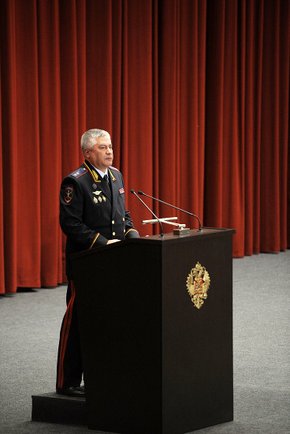Ministry of Internal Affairs (Russia) facts for kids
| Министерство внутренних дел Российской Федерации Ministerstvo vnutrennikh del Rossiyskoy Federatsii |
|
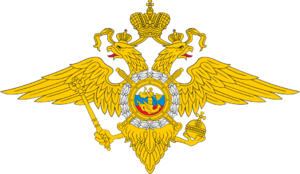
Ministry emblem
|
|
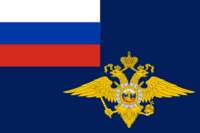
Ministry flag
|
|
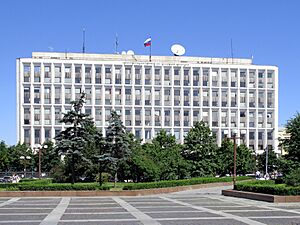 Ministry headquarters in Moscow |
|
| Agency overview | |
|---|---|
| Formed | 8 September 1802 |
| Preceding agencies |
|
| Jurisdiction | President of Russia |
| Headquarters | Zhitnaya St. 16, Yakimanka, Moscow, Russia 55°43′51″N 37°36′50″E / 55.73083°N 37.61389°E |
| Employees | 907,630 (2012) |
| Annual budget | 1192.2 billion roubles (FY 2011) |
| Minister responsible |
|
| Child agencies | |
The Ministry of Internal Affairs of the Russian Federation (MVD) is like the main police department for Russia. Its job is to make sure laws are followed and people are safe.
The MVD works through different groups. These include the Police of Russia, the team that handles migration (people moving in and out of the country), and the group that deals with drugs. They also have a team for traffic safety and an Investigative Department. The MVD's main office is in Moscow. Since 2012, Vladimir Kolokoltsev has been the head of the MVD.
Contents
History of the MVD
Early Days: Russian Empire (1802-1917)
The very first MVD in Russia was started by Tsar Alexander I in 1802. It was one of the most powerful parts of the government. It was in charge of police forces and special guards. The MVD also oversaw local governments.
At first, it had many jobs, like managing prisons, firefighting, and even roads. But over time, many of these tasks were given to other government groups.
Police in the Empire
As the country grew, police chiefs called ispravniks were placed in different areas. Under them were commissaries. These police officers had a lot of power. Later, special mounted police called uryadniks were created to keep order in the countryside. They could arrest people they suspected of crimes. In towns, every house had a "porter" or dvornik. This person was supposed to report anything unusual to the police.
Secret Police in the Empire
There was also a secret police that worked directly for the MVD. Their main job was to find and stop political problems. One famous part of this was the "Third Section," started in 1826. It was separate from the regular police. Its goal was to keep the emperor informed about what was happening in the country.
Later, the Department of State Police took over these secret police duties. By World War I, this department also had a team to stop spies. After the February Revolution in 1917, these secret police groups were stopped.
Soviet Era (1917-1989)
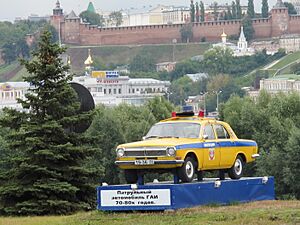
After the October Revolution, the old police were replaced. A new "Workers' and Peasants' Militsiya" was formed. This was under the NKVD of the Russian SFSR. When the USSR was created, there wasn't a federal NKVD until 1934.
In 1946, the NKVD became the MVD of the USSR. Its secret police part, the NKGB, became the MGB. For a short time in 1953, the secret police became part of the MVD again. But soon after, the MVD went back to its police duties, and a new group called the KGB handled state security.
In 1960, the All-Union MVD was temporarily closed. Its jobs were given to the MVDs in each Soviet Republic. But in 1966, the All-Union Ministry was brought back. The MVD also started to fight "economic crimes." This meant stopping private businesses, which were mostly not allowed under the law back then.
Modern MVD: Russian Federation (1990-Present)
The Russian MVD was re-formed in 1990. It kept its duties when Russia became independent from the Soviet Union in 1991. Today, the MVD controls the Politsiya (which used to be called Militsiya) and the General Administration for Traffic Safety.
In 2003, the MVD also started investigating financial crimes. Some older parts of the MVD, like the firefighting service and prisons, moved to other ministries in the early 2000s. In 2012, Vladimir Kolokoltsev, who had worked as a police officer, became the Minister of Internal Affairs.
In 2016, some parts of the MVD, like the Internal Troops and special police units (OMON and SOBR), became part of the new National Guard of Russia. At the same time, the Federal Drug Control Service and the Federal Migration Service joined the MVD. They are now known as the Main Directorate for Drugs Control and the Main Directorate for Migration Affairs.
Recent Events (2020-Present)
In 2023, the MVD was involved in a court case for a jailed opposition leader, Alexey Navalny. His appeal was held in private and then rejected.
Also, phone and internet companies in Russia must give the MVD access to their customer information. This allows the Ministry to look at phone calls and internet use without people knowing.
Ministers of Internal Affairs
Here are the people who have led the MVD since 1992:
| Minister | Start year | End year |
|---|---|---|
| Viktor Yerin | 1992 | 1995 |
| Anatoly Kulikov | 1995 | 1998 |
| Sergei Stepashin | 1998 | 1999 |
| Vladimir Rushailo | 1999 | 2001 |
| Boris Gryzlov | 2001 | 2003 |
| Rashid Nurgaliyev | 2004 | 2012 |
| Vladimir Kolokoltsev | 2012 |
See also
- Awards of the Ministry of Internal Affairs of Russia
- List of interior ministers of Russia
- Militsiya
- Moscow Police
Images for kids



